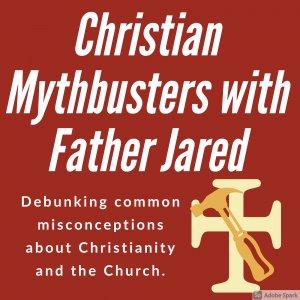Christian Mythbusters

Resurrection Myths
In this episode of Christian Mythbusters, Father Jared breaks some of the myths about the resurrection of Christ which we celebrate during Eastertide. You can hear Christian Mythbusters in the Grand Haven area on 92.1 WGHN, on Wednesdays at 10:30am and Sundays at 8:50am. You can also subscribe to the podcast on Apple here. The transcript of the episode is below, or you can listen to the audio at the bottom of the post. This is Father Jared Cramer from St. John’s Episcopal Church in Grand Haven, Michigan, here with today’s edition of Christian Mythbusters, a regular segment I offer to counter some common misconceptions about the Christian faith. Usually, right around this time of year, I get the delight of wishing people a Happy Easter and enjoying the quizzical looks they give me in return. You see, in the tradition of the church, Easter isn’t just one Sunday, it’s Fifty Days of feasting—fifty days of feasting after the forty days of Lent. That’s because the resurrection of our Lord and Savior Jesus Christ is such a profound reality-changing event that it needs a full fifty days to celebrate it. That also explains why my daughter is still eating Easter candy, much to the occasional annoyance of my wife! My daughter is just traditional in her celebrations, even at four years old. But these continued Easter celebrations raise a question I hear sometimes… just what was the resurrection anyway? What does it mean when we say we believe Jesus rose from the dead? Did a corpse come back to life? Was it a resuscitation, like when paramedics bring back someone whose heart stops, just one that is more miraculous because it took place after Jesus was dead for three days? All of these questions, I think, mean today is a great day to break some of the myths about the resurrection of Christ which we celebrate during Eastertide. First, the resurrection of Christ was not the mere resuscitation of a corpse. It can be compared to Lazarus, for instance, who Jesus bodily raised from the dead—resuscitated—after Lazarus had been dead for four days. However, Lazarus’s original body was raised up and that means that Lazarus still grew old and eventually Lazarus did finally die. Jesus’s resurrected body, however, was very different from his body that was put to death by a violent state and jealous religious powers. For one thing, it seems that Jesus’s disciples did not immediately recognize him—often, not until he heard them say their name or he showed them his wounds. For another, in his resurrected body, he seemed able to enter and exit rooms with locked doors. And the point that he was raised with his wounds is deeply important, emphasizing that God did not erase the painful path, but that God makes it new. Some would suggest that maybe the experience of the disciples was some kind of mass hallucination, or at least an experience of a spiritual being who came back after Jesus’s death. And yet, the Scriptural witness is clear that though his resurrected body was different, it was still a body. He was not some kind of ghost or spiritual being. When his disciples struggled to believe, he ate a piece of fish with them, demonstrating that he was indeed bodily there. He invited St. Thomas to stick his hand right into his side and to probe the holes in his pierced hands with his fingers. Jesus breathed on the apostles, giving them the gift of the Holy Spirit. And St. John is abundantly clear that Jesus was raised bodily when he begins his first epistle,






 Visit Podcast Website
Visit Podcast Website RSS Podcast Feed
RSS Podcast Feed Subscribe
Subscribe
 Add to MyCast
Add to MyCast